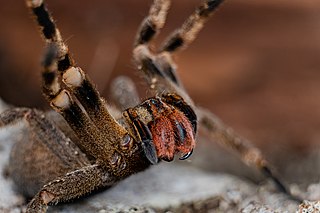
Phoneutria is a genus of spiders in the family Ctenidae. Phoneutria venom is potentially medically significant to humans. They are mainly found in northern South America, with one species in Central America. Members of the genus are commonly referred to as Brazilian wandering spiders. Other English names include armed spiders and banana spiders.

Wandering spiders (Ctenidae) are a family of spiders that includes the Brazilian wandering spiders. These spiders have a distinctive longitudinal groove on the top-rear of their oval carapace similar to those of the Amaurobiidae. They are highly defensive and venomous nocturnal hunters. Wandering spiders are known to hunt large prey, for example hylid species Dendropsophus branneri. Despite their notoriety for being dangerous, only a few members of Phoneutria have venom known to be hazardous to humans, but the venoms of this family are poorly known, so all larger ctenids should be treated with caution.
A latrotoxin is a high-molecular mass neurotoxin found in the venom of spiders of the genus Latrodectus as well as at least one species of another genus in the same family, Steatoda nobilis. Latrotoxins are the main active components of the venom and are responsible for the symptoms of latrodectism.
Phoneutria bahiensis is a species of spiders in the family Ctenidae, found in Brazil. It's known in Brazilian Portuguese as Armadeira da Bahia,.

Phoneutria boliviensis is a species of a medically important spider in the family Ctenidae found in Central and South America.

Phoneutria nigriventer is a species of medically significant spider in the family Ctenidae, found in the Southern Cone of South America. Along with other members of the genus, they are often referred to as Brazilian wandering spiders.
Phoneutria reidyi is a species of venomous spiders in the family Ctenidae, found in South America.
Tx2-6 is a toxin found in the venom of the Brazilian wandering spider, Phoneutria nigriventer(Keyserling). It is a peptide of 48 residues, molecular weight 5291.3. This peptide is cleaved from a longer precursor with a signal peptide and a glutamine-rich propeptide. It can cause priapism. Tests on rats indicate that the toxin causes nitric oxide release, and its effect on erection is blocked by the nitric oxide synthase inhibitor L-NAME. However, it fully restored erectile function in rats developing hypertension due to injection of deoxycorticosterone acetate. A study is underway at the Medical College of Georgia looking at possible uses for the chemical in erectile dysfunction medication. Scientists and Gregory Ochs are collaborating on this study.
Phoneutria keyserlingi is a species of spiders in the family Ctenidae, found in Brazil.
AETX refers to a group of polypeptide neurotoxins isolated from the sea anemone Anemonia erythraea that target ion channels, altering their function. Four subtypes have been identified: AETX I, II, III and K, which vary in their structure and target.
Piscivorin is a component of snake venom secreted by the Eastern Cottonmouth. It is a member of the cysteine-rich secretory protein (CRISP) family, which blocks voltage-dependent calcium channels.
Latisemin is a cysteine-rich secretory protein that can be isolated from the venom of the Black-banded sea krait, a sea snake indigenous to the warmer waters of the western Pacific Ocean. It is a toxin that inhibits cyclic nucleotide-gated ion channels and blocks L-type calcium channels, thereby reducing smooth muscle contraction.
Huwentoxins (HWTX) are a group of neurotoxic peptides found in the venom of the Chinese bird spider Haplopelma schmidti. The species was formerly known as Haplopelma huwenum, Ornithoctonus huwena and Selenocosmia huwena. While structural similarity can be found among several of these toxins, HWTX as a group possess high functional diversity.
The pathophysiology of a spider bite is due to the effect of its venom. A spider envenomation occurs whenever a spider injects venom into the skin. Not all spider bites inject venom – a dry bite, and the amount of venom injected can vary based on the type of spider and the circumstances of the encounter. The mechanical injury from a spider bite is not a serious concern for humans. Some spider bites do leave a large enough wound that infection may be a concern. However, it is generally the toxicity of spider venom that poses the most risk to human beings; several spiders are known to have venom that can cause injury to humans in the amounts that a spider will typically inject when biting.

Loxosceles gaucho commonly known in English as the gaucho spider. is a highly venomous recluse spider endemic to South America.
PhTx-1 is a toxic fraction isolated from the venom of the Brazilian wandering spider Phoneutria nigriventer.
U7-ctenitoxin-Pn1a (or U7-CNTX-Pn1a for short) is a neurotoxin that blocks TRPV1 channels, and can exhibit analgestic effects. It is naturally found in the venom of Phoneutria nigriventer.

Delta hexatoxin Hv1 is a neurotoxic component found in the venom of the Australian funnel web spider.
Phoneutria depilata is a species of spider in the family Ctenidae, found in Central America.
U24-ctenitoxin-Pn1a is a neurotoxin that is naturally found in the venom of Latrodectus geometricus (L.geometricus). It reduces the inactivation of insect voltage-gated sodium channels. It is also thought to be a cysteine proteinase inhibitor.





